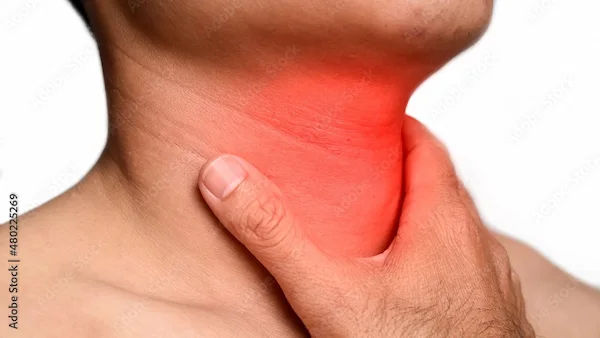Guide to Plummer Vinson Syndrome
Learn about Plummer-Vinson Syndrome, a rare condition causing difficulty swallowing and iron deficiency anaemia. Understand symptoms, causes, diagnosis, treatment, and long-term outlook.

Written by Dr. Dhankecha Mayank Dineshbhai
Reviewed by Dr. Vasanthasree Nair MBBS
Last updated on 26th Sep, 2025

Introduction
Have you ever experienced a persistent feeling that food is getting stuck in your throat, especially when eating solid foods? While occasional swallowing trouble can happen, when it is combined with constant fatigue, pale skin, and brittle nails, it could point to a specific, though rare, condition known as Plummer-Vinson Syndrome (PVS). This syndrome represents a unique intersection of nutritional deficiency and a physical change in the oesophagus, primarily affecting middle-aged women. Understanding PVS is crucial because, while it is treatable, leaving it unaddressed can lead to more serious complications.
This comprehensive guide will walk you through everything you need to know about Plummer-Vinson Syndrome, from its hallmark symptoms like dysphagia and signs of iron deficiency anaemia, to the diagnostic process and effective treatments such as iron supplementation and oesophageal dilation. Our goal is to empower you with knowledge so you can seek timely medical advice if you recognise these signs in yourself or a loved one.
What is Plummer-Vinson Syndrome?
Plummer-Vinson Syndrome (PVS), also sometimes referred to as Paterson-Brown-Kelly syndrome, is a rare condition characterised by a classic trio of symptoms: iron deficiency anaemia, difficulty swallowing (dysphagia), and the presence of an oesophageal web. An oesophageal web is a thin, membrane-like growth of tissue that projects into the swallowing tube (oesophagus), partially obstructing it. This syndrome is most commonly diagnosed in middle-aged women.
Think of PVS as a chain reaction. It often begins with a long-standing deficiency of iron in the body. This deficiency does not just cause anaemia; it is believed to lead to changes in the mucous membranes lining the oesophagus,
eventually causing the formation of the web. This web is what creates the sensation of food sticking in the upper throat.
The Triad of Key Features
The diagnosis of PVS is typically based on identifying these three interconnected features:
- Iron Deficiency Anaemia: A condition where the body lacks enough healthy red blood cells due to insufficient iron.
- Dysphagia: A persistent difficulty in swallowing, specifically for solid foods.
- Oesophageal Web: A thin, web-like membrane in the upper oesophagus.
Consult Top Doctors for Your Symptoms
Recognising the Signs: Symptoms of Plummer-Vinson Syndrome
The symptoms of PVS are a direct reflection of its two main components: the oesophageal web and the underlying iron deficiency. Recognising these signs is the first step towards getting help.
Difficulty Swallowing (Dysphagia)
This is often the most noticeable symptom. Individuals with PVS do not typically have trouble with liquids; the problem arises with solid foods, especially meat and bread. They may feel that food is sticking or moving very slowly down the throat in the upper chest area. This sensation can be frightening and may lead to weight loss due to avoidance of certain foods.
Signs of Iron Deficiency Anaemia
Because anaemia is a core part of PVS, many symptoms are related to the reduced oxygen-carrying capacity of the blood. These include:
- Fatigue and weakness: Feeling unusually tired and lacking energy.
- Pale skin (pallor) and pale conjunctiva: A noticeable loss of colour in the face and inner lining of the eyelids.
- Brittle nails or koilonychia: Nails that are soft, brittle, and may become concave or spoon-shaped.
- Glossitis and cheilosis: A sore, red, swollen tongue and cracks or sores at the corners of the mouth.
Other Potential Symptoms
Some people may also experience chest pain, heartburn, or a persistent cough. In severe cases, the spleen may become slightly enlarged (splenomegaly).
What Causes Plummer-Vinson Syndrome?
The exact cause of Plummer-Vinson Syndrome is not fully understood, but it is overwhelmingly linked to one primary factor.
The Primary Suspect: Chronic Iron Deficiency
The leading theory is that long-term, severe iron deficiency is the main driver. Iron is essential for the enzymes that maintain healthy mucosal tissue. When iron is lacking, the cells in the oesophagus may not regenerate properly, leading to atrophy (thinning) and, eventually, the formation of the web. However, not everyone with iron deficiency develops PVS, suggesting that other genetic or autoimmune factors may play a role in susceptible individuals.
Who is Most at Risk?
PVS is most commonly seen in:
- Middle-aged women: Particularly between the ages of 30 and 50.
- Individuals with chronic blood loss: Such as from heavy menstrual periods, or slow bleeding from the gastrointestinal tract.
- Those with poor nutritional intake: Diets consistently low in iron-rich foods can contribute.
Getting a Diagnosis: How is Plummer-Vinson Syndrome Identified?
If you are experiencing symptoms suggestive of PVS, a doctor will follow a systematic approach to diagnosis. If
symptoms like difficulty swallowing persist beyond two weeks, consult a doctor online with Apollo24|7 for further
evaluation.
Medical History and Physical Exam
The doctor will ask detailed questions about your swallowing difficulties, diet, energy levels, and medical history
(especially regarding anaemia or blood loss). A physical exam will look for signs of anaemia, such as pale skin and
brittle nails.
Essential Diagnostic Tests
Confirmation of PVS requires specific tests to visualise the oesophagus and confirm iron deficiency.
1. Blood Tests to Check for Anaemia
A complete blood count (CBC) will show if you have anaemia. Further tests, like serum iron, ferritin, and total iron-
binding capacity (TIBC), will confirm that the anaemia is due to iron deficiency. Apollo24|7 offers convenient home
collection for tests like CBC and ferritin levels.
2. Barium Swallow Study
You will drink a chalky liquid containing barium, which coats the oesophagus. As you swallow, X-rays are taken. The barium outlines the oesophagus, making any webs or narrowings clearly visible as thin, shelf-like indentations.
3. Endoscopy: The Definitive Test
An upper endoscopy is the most accurate way to diagnose an oesophageal web. A thin, flexible tube with a camera (endoscope) is passed through your mouth into the oesophagus. This allows the doctor to directly see the web and, importantly, to perform a dilation procedure to break it during the same session. It also allows for a biopsy to rule out other causes, including cancer.
Effective Treatment for Plummer-Vinson Syndrome
The good news is that PVS is highly treatable, and treatment is focused on addressing both components of the syndrome.
Correcting the Iron Deficiency
The first line of treatment is iron replacement therapy, usually with oral iron supplements. It is important to take these as directed, and your doctor may recommend taking them with vitamin C to enhance absorption. Treating the underlying cause of the iron deficiency, such as managing heavy periods, is also essential. In severe cases, intravenous iron may be necessary.
Addressing the Oesophageal Web
Simply correcting the iron deficiency can sometimes improve swallowing over time. However, if the web is causing
significant obstruction, it needs to be physically treated. This is typically done through oesophageal dilation. During an upper endoscopy, the doctor can pass a dilator (a small balloon or a tapered plastic bougie) through the endoscope to gently stretch and tear the thin web. This procedure is highly effective and provides immediate relief from dysphagia. It is generally safe and well-tolerated.
Long-Term Outlook and Potential Complications
With proper treatment, the prognosis for Plummer-Vinson Syndrome is excellent. Symptoms of dysphagia often resolve quickly after dilation, and iron levels normalise with supplementation.
The Link to Oesophageal Cancer
This is the most significant long-term concern. Studies have shown that individuals with PVS have a higher risk of
developing squamous cell carcinoma of the oesophagus later in life. The exact reason is unclear, but it may be related to chronic irritation from the web or the same underlying mucosal vulnerability. This is why successful treatment and long-term follow-up with a gastroenterologist are crucial. If your condition does not improve after treatment, book a physical visit to a specialist with Apollo24|7 for ongoing management.
Can Plummer-Vinson Syndrome Be Prevented?
Prevention revolves around avoiding prolonged iron deficiency. This includes:
- Eating a balanced diet rich in iron, such as red meat, poultry, fish, leafy greens, beans, and iron-fortified cereals.
- Seeking medical attention for symptoms of anaemia or chronic blood loss, such as heavy periods or blood in stool.
- For at-risk individuals, regular health check-ups that include screening for anaemia.
Conclusion
Plummer-Vinson Syndrome serves as a powerful example of how a nutritional deficiency can manifest as a tangible physical problem. While it may sound complex, its management is typically straightforward and highly successful. The key is awareness. Recognising the combination of persistent swallowing difficulties and signs of anaemia, such as fatigue, pale skin, and brittle nails, should prompt a timely visit to a healthcare provider. Modern diagnostic tools like endoscopy allow for precise identification and treatment of the oesophageal web, often in a single procedure. Coupled with iron replacement, this leads to a rapid improvement in quality of life. If you suspect you or someone you know might be experiencing symptoms of PVS, do not hesitate to seek medical advice. Early intervention is the best strategy for a full recovery and long-term health.
Consult Top Gastroenterologists
Consult Top Gastroenterologists

Dr. B Prabhakar
Gastroenterology/gi Medicine Specialist
21 Years • MD, DM (GE)
Hyderguda
Apollo Hospitals Hyderguda, Hyderguda

Dr. Lekkala Rajesh
Gastroenterology/gi Medicine Specialist
12 Years • MBBS, DNB Internal Medicine DrNB Medical Gastroenterology and Hepatology | Medical Gastroenterology
Secunderabad
Apollo Hospitals Secunderabad, Secunderabad
(75+ Patients)

Dr. Bharani Immaneni
Gastroenterology/gi Medicine Specialist
12 Years • MD DM Gastroentrology
Secunderabad
Apollo Hospitals Secunderabad, Secunderabad
(75+ Patients)

Dr. Jatin Yegurla
Gastroenterology/gi Medicine Specialist
11 Years • MD (PGI), DM (AIIMS Delhi), FAGIE (AIIMS Delhi), ESEGH (UK), Gold Medalist
Hyderabad
Apollo Hospitals Jubilee Hills, Hyderabad
(650+ Patients)

Dr Harish K C
Gastroenterology/gi Medicine Specialist
15 Years • MBBS MD DM MRCP(UK) (SCE-Gastroenterology and Hepatology)
Bengaluru
Apollo Clinic, JP nagar, Bengaluru
Consult Top Doctors for Your Symptoms

Dr. B Prabhakar
Gastroenterology/gi Medicine Specialist
21 Years • MD, DM (GE)
Hyderguda
Apollo Hospitals Hyderguda, Hyderguda

Dr. Lekkala Rajesh
Gastroenterology/gi Medicine Specialist
12 Years • MBBS, DNB Internal Medicine DrNB Medical Gastroenterology and Hepatology | Medical Gastroenterology
Secunderabad
Apollo Hospitals Secunderabad, Secunderabad
(75+ Patients)

Dr. Bharani Immaneni
Gastroenterology/gi Medicine Specialist
12 Years • MD DM Gastroentrology
Secunderabad
Apollo Hospitals Secunderabad, Secunderabad
(75+ Patients)

Dr. Jatin Yegurla
Gastroenterology/gi Medicine Specialist
11 Years • MD (PGI), DM (AIIMS Delhi), FAGIE (AIIMS Delhi), ESEGH (UK), Gold Medalist
Hyderabad
Apollo Hospitals Jubilee Hills, Hyderabad
(650+ Patients)

Dr Harish K C
Gastroenterology/gi Medicine Specialist
15 Years • MBBS MD DM MRCP(UK) (SCE-Gastroenterology and Hepatology)
Bengaluru
Apollo Clinic, JP nagar, Bengaluru
More articles from Dysphagia
Frequently Asked Questions
Q1. Is Plummer-Vinson Syndrome the same as Paterson-Brown-Kelly syndrome?
Yes, they are the same condition. Plummer-Vinson Syndrome is the more commonly used name in the United States, while Paterson-Brown-Kelly syndrome is often used in the UK.
Q2. Can the difficulty swallowing from an oesophageal web come and go?
It can fluctuate, but it typically worsens over time, especially with solid foods. The sensation is often consistently present when trying to swallow specific items like meat or dry bread.
Q3. What is the difference between an oesophageal web and a stricture?
An oesophageal web is a very thin, membrane-like growth, usually in the upper oesophagus. A stricture is a more generalised narrowing or tightening of the oesophageal tube, often caused by chronic acid reflux leading to scarring, and it tends to be thicker and longer than a web.
Q4. How long does it take for iron levels to improve with treatment?
You may start to feel less fatigued within a few weeks of starting iron supplements. However, it can take several months for your iron stores (ferritin levels) to return to normal. Your doctor will monitor your levels with blood tests.
Q5. Does the oesophageal web grow back after dilation?
Recurrence is possible but not very common, especially if the underlying iron deficiency is successfully corrected. Some patients may require a repeat dilation procedure if symptoms return.
